Sanoor
| Sanoor | |
|---|---|
|
National Highway Sign Board at Sanoor | |
| Country |
|
| State |
|
| District | Udupi |
| Grama Panchayath | Sanoor Grama Panchayath |
| Headquarters | Udupi |
| Talukas | Karkala |
| Population (2001) | |
| • Total | 6,328 |
| Languages | |
| • Official | Kannada |
| • Spoken languages | Tulu, Kannada, Konkani, Beary |
| Ethnicity | |
| • Ethnic groups | Hindu, Jain, Muslim, Christian |
| Time zone | IST (UTC+5:30) |
| PIN | 574 114 |
| Telephone code | 8258 |
| Nearest city | Mangalore |
| Sex ratio | 1.11 ♂/♀ |
| Literacy | 90% |
| Lok Sabha constituency | Chickamagalur Loksabha Constituency |
| Vidhan Sabha constituency | Karkala Vidhansabha Kshethra(122nd) |
| Distance from Mysore | 250 kilometres (160 mi) (land) |
| Distance from Bangalore | 380 kilometres (240 mi) (land) |
| River Shambhavi originates here and joins Arabian Sea at Mulky | |
Sanoor is a village in the southern state of Karnataka, India.[1][2] The name Sanoor literally means "Small village", in Kannada. Economy is based mainly on agriculture and secondarily on labour. There are few big hamlets in the village, namely, Irvathuru, Pulkeri, Murathangady, Aayere and Thanada gudde.
During the colonial 5 era, the village was headed by the Patels (Patler). Upon independence, the administration is handled by the Village Mandala Panchayath. For justice, the nearest court is at Karkala town which is at 5 km distance from the village center. There are few primary schools and one Government Pre-university College. Tulu language is widely spoken. Other languages that are spoken in the village are Konkani and Kannada. Bunts, Nadavas, Billavas and Jains are the ethnic communities and the others namely Marathis, Konkanis, Brahmins are believed to be the early migrants. With the Portuguese wave, soon the village gave birth to Catholic Christians through religious conversion. The local Muslims belong to Moplah community are known as Bearys, who speak a dialect called Beary bashe. The community seem to exist in the region for thousand over years. The Bearies are perhaps the descendents of those Arab (Baharis - Outsiders or Overseas) traders who might have mixed with the local population during the course of their trade with the local kingdom.
Geography
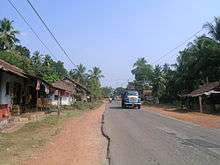
It is located in the Karkala taluk of Udupi district in Karnataka. The river Shambhavi originates here and flows across the village into Arabian Sea at Mulky. The nearest coastal town is Surathkal which is 22 km away through road. The village is located on the slope of the Sahyadri hill, the Western Ghat. Due to hill ranges, the population density is seen on the slopes between the hills or beside the river banks. Tropical wet evergreen type of forest is seen here. With the agricultural reforms, one can view Cashew plantaions on the smaller hills. The village receives highest rainfall in the district.
The village has a Mandala Panchayath that includes few Panchayaths of surrounding villages and takes care of administration. The main street that stretches for about a KM has shopping lines on both the sides. The varieties of shops are seen here starting from electrical, medical clinic, Post Office, Vijaya Bank, Restaurants, Grocery shops, Beauty Saloon, Tailor shops, Bicycle Repair shops, Community centre, Public function hall etc.
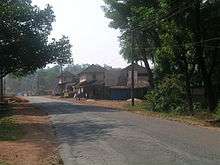
A small hillock makes a short break to the shopping line, which otherwise would have stretched up to Murathanagady. On one side of this small hillock is a Sanoor Seed Farm. Seed farm develops varieties of rice seeds that is given to the farmed at subsidised price. The seed farm is vast and has many varieties of trees that include Mangoes, Sapota and Jack-fruits.
History
The region was originally under the rule of the Alupas. Subsequently, between 13th and 16th century, the village was under the rule of Bhairarasa Odeyas of Kalasa-Karkala kingdom. The village has a Siva temple and Nada Daiva-shrine. Once this place was filled with shaiva people, but now it is replaced with billavas, Muslims, konkanis.
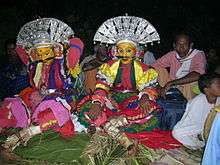
The district has two ancient traditions namely Bhootada Kola and Nagaradhane.
Bhoota Kola, the spirit worship, is a highly stylised version of the ritual dance of the spirit impersonator. There is a main shrine where yearly Nema is performed.
Fauna
Sanoor, being in the Sahyadri hill range, is a home for several hundreds of birds, many reptiles and mammal species. As there are only small scale food related industries, the area is unpolluted. The commonest among the birds are common crows, pipits and partridges. Other birds such as Kingfisher, Pipt, Asian Koel, Parakeet, Black kite, Falcon, Brahmini kite, Treepie, Black woodpecker, whistling thrush, Rock pigeon, Eagle etc. are seen almost wherever and whenever you pass by. One can see Rufous babblers foraging in noisy groups. As there is totally a lack of interest in preserving tree, one can see even the Peacocks in the village. Earlier, peacocks were only heard from distance but not seen. During summer, the migratory birds visit the village and causes too much of noise, especially in the evening.
Mammals such as Mongoose, jungle cat, leopard, porcupine, wolf, wild pig, Monitor, monkeys are spotted here occasionally. Tiger was last spotted in 1975. It had accidentally fallen into the un-used well. Eventually, it was rescued and moved to the nearby Dharmasthala Zoo.
The hillocks of the village are known to have an endangered species of tortoise such as star tortoise and pangolin.
Russell's viper, saw-scaled viper, cobra and the kraits are the four venomous snakes encountered often by the public. Though statistics prove that there are more death due to Rabies than by snakebite, snakebite seems to be a traumatic experience that many people in the villages think more about it. The snake bite is still frequently associated with gods and devils and hence the practise of Naga worship. Only Krait bite does not show any pain but is fatal. Most of bites caused by the other three species are mostly non-fatal and are dry bites.The quantity of venom that the reptile injects is a voluntary phenomenon though the venom sac is full.
With the constant destruction of forests and creation of agricultural field, the snakes that live these fields are getting more and more. The rice fields harbour millions of rats and so is the population of snakes. The humans going into the fields every morning and coming out in the evening encounter snakes often as this is the time when snakes are active.
Agriculture
History of rice cultivation here is as similar to the rest of India. With Aryan migration, the Dravidians were pushed to the south, and the wheat culture of the Aryans is restricted only to North India. The south still retained rice as their staple food which might have originated in the region of Bengal. Agriculture in Sanoor mainly depends on the river Shambhavi for irrigation, which originates in Sanoor and ends up at sea in Mulky. Dry land is mainly dependent on the untimely rainfall. Lands are classified into categories, namely Wet and Dry. River flow is blocked during the summer so that irrigation is possible by lifting water from the rivers. Otherwise, rivers are generally dry during peak summer. Monsoon brought rain during May to August. Three paddy crops are cultivated depending on the land type. Dry land allows only one crop a year and wet land sometime yields two or three depending on the irrigation availability.
In the ancient period, chewing Betel leaves along with Chuna and Areca nut was one of the habits people were addicted to. With the growing awareness on the harmful effects of this, the cultivation of betal vines and the trees that is supportive for this cultivation, are seen only in isolated patches. With the scarcity of manpower availability, people have transformed some of the land to coconut and areca tree plantation. Coconuts are heavily consumed in the local cuisines. In the 1950s, the rice mills budded in the village and soon one could see farmers relying on these mills instead of labour-intensive hand-pounding of steamed-dried paddy. Couple of Oil mills are still seen running due to constant availability of local coconuts. Around 1990, the focus shifted to the cashew industry, and rice mills depend on supply from adjacent places such as Shimoga, Teerthahalli.
Cashew plant is grown and even farmed in the village. While the plant is native to Venezuela and Brazil, The Portuguese brought the cashew plant to Goa around mid 16th century AD. Cashew nut has high nutritional value and was perhaps favourite among the Portuguese sailors because of long lasting, portability and density of nutrients. Also, the plant was brought due to the usage of cashew in their culinary recipes and in producing the liquor "Feni" locally. Soon, it spread throughout the west coast of Goa, Karnataka and Kerala. As the time passed, the sailors carried it to Indonesia and Africa too. Today, the slopes of Sahyadri hill range has proved a favourite climate for the cashew. Since the local soil condition and climate was already in favour of the native breed Semecarpus anacardium (also known as Ker Beeja) plant, the cashew plant of Brazil, which also belongs to the family, grew fertile. These cashews retained the name of the seed of local plant - Geru Beeja as derived from the word Ker Beeja. The cashew harvested in Sanoor is inline with the taste of those grown in Kerala. Of all the known cashew seeds, the local cashew seeds are the best and most preferred for texture, size and taste.
Sanoor has several cashew processing units, each employs about several hundreds of employees. The processed cashew is exported to other countries. Due to increased domestic demand for the processed cashews, the raw cashews are imported from Indonesia and Africa when the local produce is fully consumed. village also has a cardanol processing unit, which extracts phenol from the anacardic acid rich cashew shells. Phenol finds its use in various chemical industries that produce coating, abrasive and resin materials.
Vegetables are the other local produce which is mostly consumed locally. Jack and Mangoes are the seasonal fruits grown locally. Varieties such as Mundappa, Thothapuri, Neelam are quite popular among the mangoe breeds. For jack-fruits, one can see numerous varieties. Each type may not have a unique name. In some cases, the naming goes by the owner's name, or the surrounding tree or the texture, fragrance etc.
Culture

Yakshagana, Kambala and Korida Katta are the three forms of local entertainment. With the TV culture, the Yakshagana Bayalata, the open field musical theater, has become a rare event. There is a local hobby club which presents the event on certain occasions. Local artist Sri Sridhar Pandy has composed hundreds of Yakshagana episodes, which are also known as Prasangas. On a cultural and religious level, some Theyyam deities are propitiated through blood sacrifice or cock-sacrifice which does also include the cockfight and is a prime example of "cultural synthesis of 'little' and 'great' cultures".[3] Cock fight, also known as Kori Katta, is a popular folk sport of the village is still popular among the locals. People usually grow different breeds of cocks just for the purpose of this folk sport, and many are very passionate about the game. The varieties of breeds include, Kemmaire, Kadla, Karbula, Kornge, Manjele, Peradinge, Uriye, etc. During this sport, Shendhi, a fish-tail palm wine, is consumed by the participants in excess. The palm wine is used extensively in the local Hindu and Christian cuisine, namely Sanna. Sanna is rice-dominant idli, also known in English as rice cake, with Shendhi (Palm wine - Toddy) used in place of yeast, for dough fermentation.
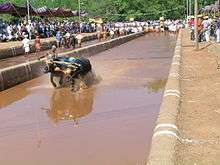
Kambala, the bull race, is specific to the district of South Canara. There are several Kambala fields such as Baradi Kambala Gaddhe where the Kambala rehearsal takes place. The village of Sanoor boasts quality participants. Sri Sundar K Acharya, who owns several pairs of bulls, has won many district level gold and silver medals in his name. The top awards such as gold and silver in the major Kambala event are still secured regularly by the local Acharya family.
Industry
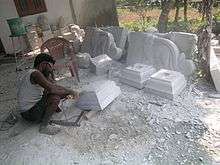
Granite hills are prominent feature of Sanoor. Several quarries exist in this region. Granite is one of the hardest types of igneous rock. Gray and Black are the two color varieties known to the local rocks. When speaking about sculpting, granite is sometimes called "monumental stone," as many monuments are made from it. Because of the hard composition of granite, it is one of the most difficult stones to carve. Stone carving tradition here dates back to the Kadamba period. The region of South Canara has several ancient granite temples of 7th to 12th century AD. These temples are mostly built in Gajaprashta architecture and is heavy in granite usage. Other than monumental use, the quarries produce stones in abundance to the local civil engineering industries for building houses, roads etc.
The other industries in the village include Rice Mills, Beedi industries, edible oil extracting mills, Cashew processing units and cardanol synthesis unit. Cashew, Areca nut palm and coconut tree plantations provide raw materials for these industries.
Beedi
“Beedis” are slim, hand-rolled, unfiltered cigarettes that has about 200 mg of sun-dried and processed tobacco flakes, rolled in a tendu leaf, held together by a cotton thread. The practise of Beedi smoking emerged perhaps in the early 18th century AD, whereas the tobacco pipe was in use for smoking tobacco until then. The oldest known Beedi manufacturing unit existed in India, in 1887, whereas Bharath Beedi founded its unit in Karkala in 1930. By 2008, the commercialization of Beedi and cigarettes took tool of smokeless tobacco consumption. Survey showed that cigarette:Beedi:Paan-Beeda consumption ratio stood at 19:53:28. There used to be exclusive shops for selling the local Paan-beeda and the last of the series "Lokayya's Beeda-shop closed down with the demise of the shop-keeper. Today, the Carambola, or starfruit tree in the Late Sabitananda Kudva's compound still stands a witness to the existing shop whose leaves were plucked to store the Chunam of the Beeda. Hard-to-wash Chuna and chewed Betal leaf stains left on the compound wall and nearby soil remind us the Beeda culture of the past.
Bidi making involves wetting, drying and cutting the tendu leaves followed by placing tobacco inside the tendu leaf, rolling the leaf and securing it with a color thread that differentiates the brand. The village of Sanoor soon became one of the centers of bidi rolling, where labor is cheaper and workmanship is better. Due to the fact that it is a cottage industry, the people preferred this over working in the field which in turn is mostly strenuous. Bidi wages are generally higher than those for manual labor, the siphoning off of women into the beedi cottage industry has raised local agricultural wages and affected cropping patterns. With the support of workers union, the industry further provide perks, bonuses, loans etc. to the workers to reains women's loyalty to contractors.
By the 1980s, popular local brands such as Bharat (No 30) and Ganesh Beedis became the two major players in the region. The scene of Tendu leaves sack and Beedis transportation in the bicycles were common to those days.
In the 1990s, the Beedi processing culture was slowly siphoned off by the new wave, the Cashew Processing. Beedi processing is still seen in the village, but it is only due to the loyalty to contractors who reward them with better perks.
Transportation
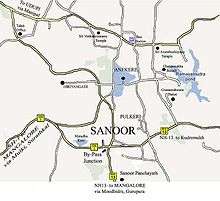
National Highway 13, the NH-13, passes through Sanoor. Other significant roads include the State Highway-1, the SH-1, that connects Kalasa-Kudremukha to Padubidri that passes through By-Pass junction of Sanoor where NH-13 cuts it across. The rural buses originate from the Karkala Bus station (City Bus Stand). There are no route numbers attributed them but the routes are assigned by the source-destination name. The nearest seaport, airport and Corporation bus station is Mangalore, which is 50 km away. There is always a Railway Station at Udupi, which is managed by the Konkan Railways (Thiruvananthapuram-Mumbai route) that connects to Goa. It is about 37 km from Sanoor.
With the InfoTech (IT) boom of this decade, the vehicle traffic through the NH-13 has been too high. The raised roads with no skirting has posed fatal accident threats to the pedestrians. As only private buses operate in this route, their rigid timing constraints have forced the drivers and conductors to be aggressive and un-friendly for the passengers. The bus staff often gets too rude especially when one is not quick enough to board or get off the public bus. The spinal injury is the common medical cases reported in the region.
The drivers who pass through the SH-1 and NH-13 should be aware of cattle sleeping on the roads, grazing beside the road. Just after the rain, one may see snakes crushed on the roads due to vehicle overrun. Since the region has too many snakes, snakes tend to go to road to get warm.
Art
Jewelry
As in other parts of India, the local jewellery is similar to the ones that are traditional to the native Udupi district and the neighbouring Dakshina Kannada, Uttara Kannada, Shimoga and Chikmagalur districts. Woman either inherits or receives jewelry at the time of wedding and other important occasions. Jewelry is a status symbol and most of the families hold jewelry as passed on for generations. There are varieties of jewelries depending on which part of the body it is worn, namely necklace, earrings, finger rings, toe rings, nose rings, bracelets, armlets, pendants, waistbands. The stone-encrusted jewellery is quite common. The local people still have a strong belief in the efficacy of the navaratnas (nine gems) in warding off evil and enhancing the beneficial effects of planets. The Navaratnas find its common use in women’s jewellery too other than the rings worn by the men.
Ear Ornaments: Kempu Bendole, the Kempu ear-stud made of red stones such as ruby is unique to this region. These are worn on ears. Jimki (eardrop) is more of a modern phenomenon of this region. Jimki is a bell-shaped ear jewel set in coloured stones with pearls hanging at the lower end. Traditional ear wear has evolved from the Karna Kundala type, the Koppu, to Vajrada Bendole, the Kudkan Jodi, which are made of natural or man made Diamonds. Wearing Bugudis on the upper ear lobes is almost extinct due to the heavy weight of the jewel. Bugudis are usually supported by the Kenne Sarapali and is hooked on to the hair to take the weight of the ornament. There is yet another type, the Lavangada Kaddi, a clove shaped ornament is worn by the class that can't afford the Bugudi. As these are of thicker stems, ear-holes are to be too broad and hence is hardly seen nowadays.
Neck jewellery is a world apart and the variety is endless. The traditional Gejje adigai has almost become an extinct due to the complexity in workmanship needed to make the necklace. Gejje Adigai is a thick herringbone band of necklace on which round bells are fixed at the bottom. The necklace of mangoes, the Kukkumudi Sara, consists of either stone-studded or the gold mangoes strung together. Pavan sara or Misri Male, the gold coin chain, consists of coins or tokens with religious figures held together or hung on the gold chain. Other jewellery includes Sarapali, the chain, Kanti, the necklace made of pearls or Coral. Chakra saras are the chains that consisted of three strings formed with golden discs or chakras. Malligemuggu Sara, the Jasmine bud necklace, the Godhi Sara that has tiny golden wheat grains, Gundu sara which is made of round beeds and Navarathna sara consisting of nine precious gems are the other popular necklaces.
The basic jewel for a married woman is the Thaali or Mangalasuthra, the Kariyamani. First tied on string and then replaced by a gold chain, the important part of the Thaali is the Pendant or Padaka, whose design is determined by the community to which the woman belongs.
The feet are adorned with Gejje (silver anklet). Oddiyaana, the gold waist belt adorns the waist. Vanki (armlet) are worn on certain occasions such as wedding, anniversary and other rituals. Hair ornament with hair pin is attached to the top of the braid or in buns to hold them in place is known as Tareta poo. Kedage, Sampige etc. are the flower patterns often seen in these pin heads. Nagara is the earlier version of Bun wear where Gopalakrishna playing flute with Serpent as umbrella is the main theme of art. Nagara has Beads in three or four rows surrounding the above theme.
For nose, Mooguthi, Moonkuda bottu and Natthu are the three known main varieties. The elderly women of older generation mostly wore Mooguthi, the nose-stud that is studded with diamond. The Natthu, the dangling nose stud was mostly worn by the younger population. It is common to see the gold tinsel on the nose, nowadays. Toe ring has the simplest design of all. Finger rings when worn on five fingers are known as Panchungila and the one that is gifted to the groom is known Vadungila. The rich brides braid is often decorated with a long Nagara plait that is studded with gems.
The children wear Sonta-da-noolu and the coral chain that has a golden Pepal leaf Padaka. With the rising gold price, the old jewelries have seen the molten pot and the new hollow, light weight jewelries are getting more popular.
Demographics
As of 2001 India census, Sanoor had a population of 6328 with 3008 males and 3320 females.[1]
See also
References
- 1 2 Village code= 1315300 "Census of India : Villages with population 5000 & above". Retrieved 2008-12-18.
|first1=missing|last1=in Authors list (help) - ↑ "Yahoomaps India :". Retrieved 2008-12-18. Sanoor, Udupi, Karnataka
- ↑ A Panorama of Indian Culture: Professor A. Sreedhara Menon Felicitation Volume - K. K. Kusuman - Mittal Publications, 1990 - p.127-128""
External links
| Wikimedia Commons has media related to Sanoor. |